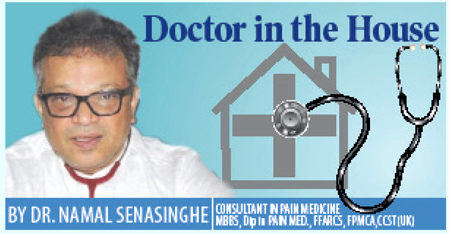
 Chronic pain is classified as pain lasting over three months. Therefore, management would be a more appropriate definition than treatment. With my experience in Sri Lanka the patients are not familiar with the word management. As a result I had to change the name from ‘London Pain Management Centre’ to ‘London Pain Clinic’.
Chronic pain is classified as pain lasting over three months. Therefore, management would be a more appropriate definition than treatment. With my experience in Sri Lanka the patients are not familiar with the word management. As a result I had to change the name from ‘London Pain Management Centre’ to ‘London Pain Clinic’.
I had callers asking my team whether this is a degree awarding centre hence the term ‘management’ ie management course/degree. All patients like to be cured ‘nittawata suva’. Don’t we all.
But chronic pain is a condition which is unlikely to be cured fully but managed in a way that helps patients to get on with life. Same with diabetes. It cannot be cured but managed. It was a challenge for me to explain to the local patients in my mother tongue what management is.
When I used the term management in my interviews I had people questions on face book ‘so no cure only management’. Being candid is key to being a good doctor. Patients should be told the truth.
But it may not go a long way with Sri Lankan patients. When patients don’t hear what they want to hear from a doctor they tend to change consultants as it is a self booking service in Sri Lanka.
When patients come to see me most of them have been to at least 4-5 consultants for the same condition ie pain. There should be a trust between the patient and the consultant. I find this lacking in Sri Lanka. Reasons are multi factorial. Only patients cannot be blamed. The biggest issue in Sri Lanka is the time spent with a patient. This has to get better with more time being spent. Challenging task.
Chronic pain can be managed in different ways. There are 4 categories of managing a patent
1. Complimentary therapy
2. Medication
3. Psycho therapy
4. Interventions (procedures)
Complimentary therapy
This is a non invasive way of treating a patient. These are
Physiotherapy
Acupuncture
Hydrotherapy
Reflexology
Medications
Medications should be used according to the WHO
classification termed the analgesic ladder. The ladder has 3 steps
1st ladder - Simple Analgesics
Paracetamol, NSAIDS such as Ibuprofen, Diclofenac,
Meloxicam, Indomethacin, Naproxen, Ketoprofen
COX 2 inhibitors
Celecoxib, Etoricoxib
2nd ladder – Moderate Analgesics
Codeine phosphate
3rd ladder - Strong Analgesic
Tramadol, Morphine’s, Fentanyl patches, Bupronorphine patches
OxyContin, Oxynorm, Pethidine
I will not go into a detail description of the individual
medications in this article.
Psychotherapy
This was dealt in my article last week. Please refer to
Sunday Observer 23/5/21
Interventions (procedures)
These are not mere injections as such but X ray guided procedures.
I will list the procedures that I carry out
• Cervical Epidural
• Thoracic Epidural
• Lumbar Epidural
• Caudal Epidural
• Shoulder Injection
• Knee Injection
• Hip Injection
• Cervical facet injection
• Thoracic facet Injection
• Lumber facet Injection
• Cervical RFD
• Thoracic RFD
• Lumbar RFD
• Dorsal Root ganglion blocks
• Dorsal root ganglion Pulse radio frequency denervation
• Lumbar Sympathetic block
• RFD Sympathetic lumbar
• Coeliac plexus block
• Ilioinguinal N block
• Femoral nerve block
• Pulse RF femoral nerve
• Genicular nerve block and RFD from 1/12/18
• Intercostal nerve block
• Paravertebral block
• Botox injections
• Trigger Point Injections
• Occipital nerve blocks
• Sacro iliac joint inj
• RFD SIJ
• Piriformis muscle block
• Suprascpular N block
• Pulse RF suprascapular Nerve
I have carried out most of the procedures in my Sri Lankan set up.
All of the above in combination or on its own can give adequate pain relief to chronic pain sufferers and improve their quality of life. No human being should suffer with pain in this day and age.
Radio frequency generator (Available in St Lanka)
Radio frequency ablation of lower lumbar facet joints
The writer is currently in England until things settle in Sri Lanka where people can move freely.
